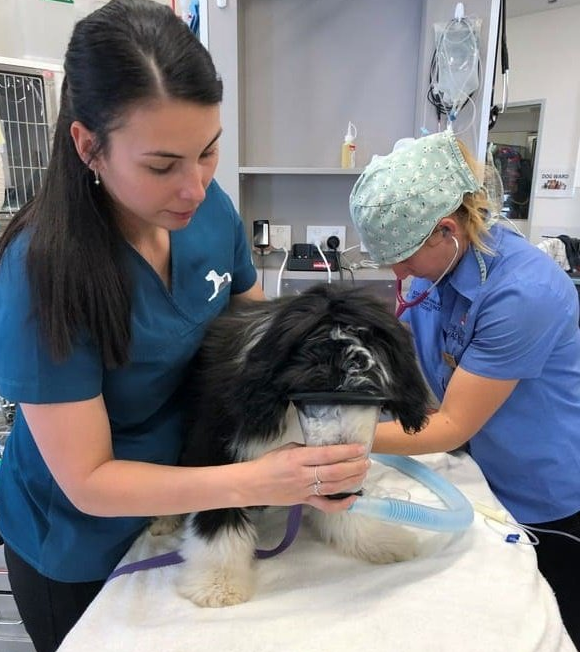Spring has finally arrived and with this glorious warm weather comes the not so glorious reminder that snakes will be emerging from hibernation and popping up in all sorts of places. Snake envenomation in dogs and cats is a life threatening event which is unfortunately a little more common than we would like! Every year we’re confronted with a number of cases of snakebite in both dogs and cats.
If left untreated, snakebite is most often a fatal disease and, as such, it’s really important that you’re aware of the dangers.
As a pet owner, it is vital that you seek immediate veterinary attention if you suspect, see or find your pet with a snake (live or dead). Time is of the essence especially in dogs, as they can collapse and die within 10 – 15 minutes of a severe envenomation. With the warm spring weather being forecast by the Bureau of Meteorology, our team has already prepared the snake bite kits, ready to respond. In the early Spring months, our team can expect to see a snake bite case daily and frequently multiple cases in a day.
Fortunately, with prompt treatment most pets can make a full recovery from a snake envenomation. Early treatment is the key.
With all this in mind, I’d like to give you a few tips regarding snakebite – what does it look like, when does it happen, what do you need to do?
Snakes are cold-blooded and become active in hot/warm weather
• As reptiles, snakes are cold-blooded creatures and rely on environmental conditions to warm themselves.
• They lie dormant throughout most of winter before coming back into action at the first signs of a warm, sunny day.
• They lie dormant throughout most of winter before coming back into action at the first signs of a warm, sunny day.
Brown snakes are highly venomous and if cornered, they will strike
• Snakes will avoid us as far as possible, and only become aggressive if cornered. When threatened brown snakes will strike multiple times in an effort to defend themselves.
• The Eastern Brown Snake is the second most venomous terrestrial snake in the world and it is the most frequent snake species found in the Gawler region.
• Red Bellied Black Snakes are not as common in our area, but do pop up at times. They like to reside near water and are a timid species that would much rather be left alone. Red Bellied Black Snakes will strike if threatened
• The Eastern Brown Snake is the second most venomous terrestrial snake in the world and it is the most frequent snake species found in the Gawler region.
• Red Bellied Black Snakes are not as common in our area, but do pop up at times. They like to reside near water and are a timid species that would much rather be left alone. Red Bellied Black Snakes will strike if threatened
Both dogs and cats will chase or hunt snakes – they think it’s fun!
• Both dogs and cats are predators and cats, in particular, are very efficient hunters. When confronted with a snake, they’re very likely to go on the attack, and this is where problems occur.
• Hunting is an inbuilt characteristic in many breeds of dog and in most cats.
• For them, it’s fun and they don’t recognise the dangers in most cases.
• Hunting is an inbuilt characteristic in many breeds of dog and in most cats.
• For them, it’s fun and they don’t recognise the dangers in most cases.
Your pets don’t learn from the experience of being bitten so ‘once bitten, twice shy’ doesn’t apply!
• The bite from a snake is not usually particularly painful at the time and the effects of the venom take some time to show.
• Unfortunately, your pet doesn’t learn that playing with a snake is a bad thing to do.
• Unfortunately, your pet doesn’t learn that playing with a snake is a bad thing to do.
Snake venom is a potent ‘neuro-toxin’ that causes muscle paralysis and weakness
• This effect can quickly result in respiratory and cardiac failure.
Weakness, collapse, paralysis and excess vocalization (in cats) are the main signs.
• Symptoms of snake bite tend to differ between dogs and cats
• This is largely related to the speed at which the venom binds to the sensitive receptors. In dogs, the venom binds very quickly. In cats, the venom usually but not always binds more slowly to the receptors
• Cats will often develop dilated pupils, be reluctant to walk/not want to move/shuffle backwards/bunny hop and be more vocal than normal. As their symptoms progress, the cat will often be found by the owner lying paralysed on it’s side with dilated pupils and miaowing.
• Dogs may have an initial collapse then appear to recover for a few minutes, be panting, anxious, dribbling/drooling, have a wobbly gait (look a little drunk)
• Not all dogs will have a collapsing episode
• If a dog has a collapse-recover episode, this indicates that the dog has most likely had a massive snake envenomation.
• This is largely related to the speed at which the venom binds to the sensitive receptors. In dogs, the venom binds very quickly. In cats, the venom usually but not always binds more slowly to the receptors
• Cats will often develop dilated pupils, be reluctant to walk/not want to move/shuffle backwards/bunny hop and be more vocal than normal. As their symptoms progress, the cat will often be found by the owner lying paralysed on it’s side with dilated pupils and miaowing.
• Dogs may have an initial collapse then appear to recover for a few minutes, be panting, anxious, dribbling/drooling, have a wobbly gait (look a little drunk)
• Not all dogs will have a collapsing episode
• If a dog has a collapse-recover episode, this indicates that the dog has most likely had a massive snake envenomation.
Snakebite is a flat-out emergency! Never sit and wait if you think your pet has been bitten by a snake.
• Although cats can take several hours to show clinical signs, dogs can die within half an hour of being bitten.
• Rarely, cats can collapse suddenly within minutes of a snake bite and behave like a dog snake bite.
• Given the timing I’ve just described above, it’s probably pretty clear that snakebite is a flat out emergency.
• Even if you’re not sure whether there has actually been a bite, you need to get in to see us as soon as possible! By all means, phone us on the way but don’t hang around on your way in here. Snake bite is definitely a case of ” Better being safe, than sorry “
• Rarely, cats can collapse suddenly within minutes of a snake bite and behave like a dog snake bite.
• Given the timing I’ve just described above, it’s probably pretty clear that snakebite is a flat out emergency.
• Even if you’re not sure whether there has actually been a bite, you need to get in to see us as soon as possible! By all means, phone us on the way but don’t hang around on your way in here. Snake bite is definitely a case of ” Better being safe, than sorry “
We can treat snakebite but you have to be quick, particularly with dogs
• We are very lucky to have an antidote to snake bite – antivenin . Antivenin is used to neutralise the effects of circulating active venom in the patient’s circulation. The key here is neutralising the active circulating venom. Once the venom has bound to the receptors, we have to treat the patient symptomatically until the venom effects wear off. The key is timing and applying this before the envenomation becomes so severe it is fatal.
• With appropriate treatment, recovery is rapid in dogs. (the venom binds quickly and the receptors recover more rapidly)
• In cats, things can move a lot more slowly (not always) and we often need several days of hospital treatment. (the venom binds more slowly and the receptors are slower to recover)
• Not all snakebite victims survive, even with treatment, but our chances are much better with rapid action. In advanced cases of snake bite, we need to address respiratory paralysis by manually ventilating the patient, along with blood clotting disorders (leading to internal bleeding) and shock.
• With appropriate treatment, recovery is rapid in dogs. (the venom binds quickly and the receptors recover more rapidly)
• In cats, things can move a lot more slowly (not always) and we often need several days of hospital treatment. (the venom binds more slowly and the receptors are slower to recover)
• Not all snakebite victims survive, even with treatment, but our chances are much better with rapid action. In advanced cases of snake bite, we need to address respiratory paralysis by manually ventilating the patient, along with blood clotting disorders (leading to internal bleeding) and shock.
A simple blood test tells us if your dog has been bitten
• It can take a while for the clinical effects of snake-bite to develop. However, snake venom usually causes changes in the clotting mechanism in dogs, which can be detected via a blood test 30 minutes after envenomation.
• We can test this to detect whether your dog has any venom in the system.
• The test only takes a few minutes to run and, if elevated, we’ll always recommend immediate treatment.
• We can test this to detect whether your dog has any venom in the system.
• The test only takes a few minutes to run and, if elevated, we’ll always recommend immediate treatment.
• Unfortunately, this test doesn’t help us with cats as they react differently.
Avoidance is better than cure
• Make sure you keep all long grass mown down in any areas your pets have easy access.
• Also don’t leave piles of wood or rubbish as this is frequently where snakes hang out.
• If you’ve already seen a snake in your yard, then it’s a great idea to call a snake-catcher (look up the web for your closest service) – for example Snake Catchers Adelaide 0413 511 440.
• There are several ‘snake posts’ on the market and some people swear by them – they are designed to deter snakes by giving off a constant vibration in the ground. Not sure how well they work but worth looking into.
• Consider leaving snake refuges in your yard – this is a place where a snake could retreat to, should it accidentally arrive in your yard. The idea behind this, is that if your pet finds a snake ‘friend’ the snake can find a safe space out of reach from your pet until you get home, avoiding the confrontation that leads to a snake bite.
• Make sure you keep all long grass mown down in any areas your pets have easy access.
• Also don’t leave piles of wood or rubbish as this is frequently where snakes hang out.
• If you’ve already seen a snake in your yard, then it’s a great idea to call a snake-catcher (look up the web for your closest service) – for example Snake Catchers Adelaide 0413 511 440.
• There are several ‘snake posts’ on the market and some people swear by them – they are designed to deter snakes by giving off a constant vibration in the ground. Not sure how well they work but worth looking into.
• Consider leaving snake refuges in your yard – this is a place where a snake could retreat to, should it accidentally arrive in your yard. The idea behind this, is that if your pet finds a snake ‘friend’ the snake can find a safe space out of reach from your pet until you get home, avoiding the confrontation that leads to a snake bite.
Now that the warm weather has arrived, you need to be really aware and on the lookout for signs of danger for your pets. If you think there’s any chance your pet has been bitten, don’t waste any time – bring them in to see us pronto.






